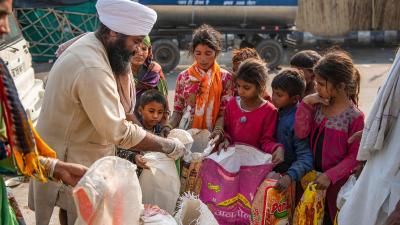Community support is higher in low-income countries
This page is approximately a 3 minute read
This page was published on

To understand the level of community support people may have in the face of natural hazards or other shocks, the 2021 World Risk Poll asked two questions – firstly, how much they think their neighbours care about them and their wellbeing and secondly, whether they have helped a stranger or someone they didn’t know in the past month. This data is used as a key measure of community resilience within the World Risk Poll Resilience Index.
The Poll revealed that more than a third (35%) of people in low-income countries say their neighbours care about them ‘a lot’, compared with only one in five (20%) in high-income countries. This measure of community support may mean that neighbours in low-income countries are more likely to help each other out in a crisis.
A Resilient World? Understanding vulnerability in a changing climate
Read the reportLikelihood of helping a stranger
In many Eastern European and Latin American countries, people are more likely to have helped a stranger but less likely to have neighbours who care about them. Around three quarters of people in the Latin America/Caribbean region (75%) and Northern America (72%) said they had helped a stranger in the past month, compared with fewer than half in Northern/Western Europe (47%) and Eastern Asia (31%).
Japan stands out as scoring the lowest on both questions, with only 20% of people saying they had helped a stranger in the past month and just 5% saying their neighbours care about them a lot. Japan has struggled with the effects of loneliness, including a rapid rise in suicides since the onset of Covid-191
- 1
Fujii, R., Konno, Y., Tateishi, S., Hino, A., Tsuji, M., Ikegami, K., Nagata, M., Yoshimura, R., Matsuda, S., & Fujino, Y. (2021). Association between time spent with family and loneliness among Japanese workers during the C-19 pandemic: A cross-sectional study. Frontiers in Psychiatry, 12, 786400.
How likely are people to help a stranger?
61% of people globally said they had helped a stranger in the past month.
Dr. Sarah Cumbers Former Director of Evidence and Insight, Lloyd’s Register Foundation
These findings are particularly important because they show strong levels of community support amongst people in low-income countries – communities that are often underserved in terms of vital infrastructure, and more likely to face disasters from natural hazards.

Understanding the impact of discrimination
Discrimination based on social and demographic characteristics can often alienate disadvantaged groups to economic opportunity, improved social mobility, safety net benefits and other factors within a community that increase people’s resilience, as well as making communities less cohesive in the face of a crisis
The Poll asked people whether they had ever been discriminated against based on their nationality, religion, skin colour, gender, or disability status.
Overall, more than one in five people (21%) worldwide said they had experienced discrimination because of one or more of these characteristics. Discrimination based on nationality, religion, sex, and skin colour were similarly common, with each experienced by around one in 10 (between 10% and 12%) of the global population, while 6% had experienced discrimination based on some form of disability.
Discrimination is undermining global resilience.
More than 1 in 5 people worldwide said they had experienced discrimination.
Places where multiple forms of discrimination are common
People in Zambia (52%), Bolivia (49%), Cameroon (49%), Uganda (49%), Brazil (48%) and the United States (46%) were most likely to have experienced one or more forms of discrimination, suggesting multiple social groups in these countries may face barriers to resources and opportunities that promote resilience.
The United States is the only high-income country in this top six. Almost a quarter (24%) of Americans said they had been discriminated against because of their skin colour, with similar proportions reporting discrimination based on their race/ethnicity (24%) and sex (23%).
How much do people think their neighbours care about them?
How much do you think most of your neighbours care about you and your wellbeing?
Download the report

A Resilient World? Understanding vulnerability in a changing climate
Revealing how people worldwide feel their country’s infrastructure and government can cope in the face of disasters, the report provides global insights into how prepared and resilient individuals believe their communities, countries and institutions are. (PDF, 5.46MB)


